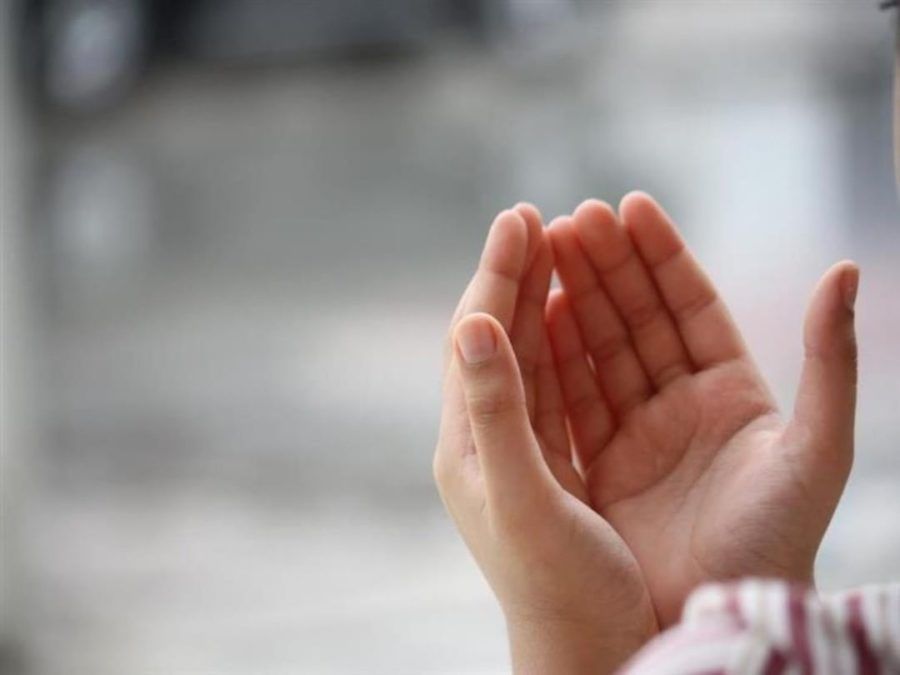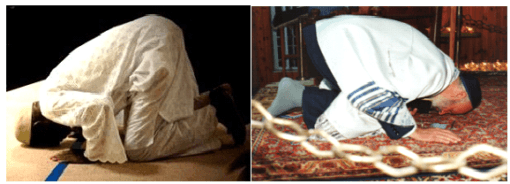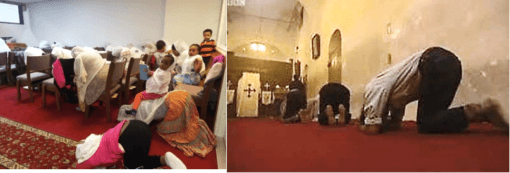
How did Jesus worship God?
Jesus (PBUH) was not sent with a new religion. He was sent to the lost sheep of Israel, to fulfill the Law of God and to bring the Jews back to the Straight Path of God (Matthew 5: 17).
As a Jew committed to the Law of God, Jesus (PBUH) was circumcised, ate the food of the Jews and attended Jews’ temples and synagogues where he practiced Jewish rituals; he even taught and explained their Law (Luke, 21:37). There is no single evidence in the four canonical Gospels which suggests that Jesus (PBUH) abandoned Judaism and worshiped God or ordered his disciples to worship Him in a different way.
Therefore, logically, we would expect spirituality in Christianity to be based on both The Old Testament, which contains the Law of God which Jesus was sent to fulfill, and the Gospels which record the practices and teachings of Jesus (PBUH).
Jesus’ prayers
The Bible does not give us firm definitions to distinguish the terms prayer, meditation and contemplation. However, Jesus (PBUH) practiced them all and from the wording of the verses and their circumstances, we may tell what form of prayer was meant or practiced.
On several occasions in the Bible, we find Jesus (PBUH) withdrawing from his followers to a solitary place to pray the whole night.
“One of those days Jesus went out to a mountainside to pray and spent the night praying to God” (Luke 6:12).
“After he had dismissed them, he went up on a mountainside by himself to pray. Later that night, he was there alone” (Matthew 14:23).
What would Jesus (PBUH) do in a solitary place all the night? It is unlikely that Jesus spent the whole night just supplicating to God. He probably (PBUH) spent the whole night communicating with God using different forms of rituals like physical prayers, supplications (vocal prayer), meditation and contemplation.
It was an opportunity for Jesus (PBUH) in his solitude to enjoy the closeness to God. He probably wanted to supplicate to God to express his love and the appreciation of God’s favors; he wanted to assert his commitment to preach the Law he was sent to fulfill; he wanted to ask God to help him in his mission to guide the sons of Israel to return back to God’s Straight Path. Jesus (PBUH) also wanted to meditate to relax and find rest after a full day of preaching people, and he wanted to contemplate the Law of God and His Transcendence and Might.
“Truly my soul finds rest in God; my salvation comes from him” (Psalm 62:1).
“Surely, it is in the remembrance of God that hearts find comfort” (Qur’an, 13:28).

Figure 1: On the left, Muslim ladies raising their hands praying to God. On the right, Ethiopian Christian ladies like Muslim ladies are praying to God while raising their hands. Notice that the Ethiopian ladies cover their heads like Muslim ladies.
Supplication (Vocal prayer)
Verses of the Bible tell us that Jesus (PBUH) was in continuous communication with God, and he was fully dependent on Him. He prayed at dawn and before leaving (Mark 1:35-36), before choosing his disciples (Luke 6:12-13), when the Jews did not believe him in spite of his miracles (Matthew 11:25-26), before and after healing people (Mark 7:31-37; Luke 5:16), before feeding people (e.g. Matthew 15:36, Mark 6:41, Luke 9:16), before eating (Luke 24:30) before walking on water (John 6:15), etc.
Meditation
“Meditate” and “meditation” are mentioned 18 times in the Old Testament and 3 times in the New Testament. The following are some examples.
“May my meditation be pleasing to him, as I rejoice in the Lord” (Psalm 104:34).
“My soul thirsts for You; my flesh longs for You in a dry and thirsty land where there is no water. So I have looked for You in the sanctuary, to see Your power and Your glory” (Psalm 63:2-3).
“This Book of the Law shall not depart from your mouth, but you shall meditate on it day and night, so that you may be careful to do according to all that is written in it. For then you will make your way prosperous, and then you will have good success” (Joshua 1:8).
“And when you pray, do not keep on babbling like pagans, for they think they will be heard because of their many words” (Matthew 6:7).
Therefore, it is obvious that meditation was practiced by the believers to demonstrate that they yearn and rejoice with their closeness to God by conversing with Him. They appreciated His favors upon them. The above verses, among many others, also draw our attention that meditation was also practiced through discursive thinking and reasoning (contemplation).
The verse in Joshua (1:18), emphasizes the great importance of the Law of God. Therefore, the believer’s should rehearse the Law of God during their meditation day and night as the verse indicates, and they should be committed to it in order to be successful. Interestingly, although Jesus (PBUH) was sent to fulfill the Law of God (Matthew 5: 17) because of its importance, after Jesus (PBUH), Paul freed people from it.

Figure 2: There are ancient Rabbinic sources stating that ancient Jews generally prostrated in every day prayers, and during the Amidah prayer.
https://www.quora.com/What-were-Jewish-prayers-like-in-early-first-century , Retrieved, 11. 2017.
Contemplation
The word contemplation does not appear in the English Christian Bible. But the elements of contemplation are found throughout the scripture. Read, for example:
“Though rulers sit together and slander me, your servant will meditate on your decrees” (Psalm 119:23).
Meditation here implies thinking and contemplation on the decrees of God. In addition, to understand the parables made by Jesus (PBUH), his followers had to be alert, watchful and contemplate their meanings. In other words, Jesus (PBUH) wanted his followers through his parables to think; to contemplate and reflect upon what was taught to them.
Also, Jesus (PBUH) asked his followers to pray privately because he wanted them to concentrate and contemplate on what they say in their prayers. He wanted them to focus and contemplate on his teachings without any sort distractions.
Physical prayer of Jesus
Kneeling and prostration to God by the prophets and their followers were the normal and common practices before Jesus (PBUH). The Bible tells us that prophets like Abraham (Genesis 17:3), Solomon (1 Kings 8:54), Moses, Aaron (Numbers 16:22; 20:6) and David (1 Chronicles 29:20), knelt and prostrated in their prayers to God.
Jewish prayer that existed in the first century was full of prostrations. The only groups today that still prostrate daily are Ethiopian, Yemenite and Karaite Jews. However, the majority of Orthodox Jews (including both Sephardic and Ashkenazi) still prostrate on the holidays of Rosh Hashanah and Yom Kippur.
As a Jew, Jesus (PBUH) supposedly performed physical prayers several times a day; kneeling and prostrating, like the prophets of God (PBUT) before him and the Prophet Muhammad and his Muslim followers after him.
“Going a little farther, he fell with his face to the ground and prayed, ‘My Father, if it is possible, may this cup be taken from me. Yet not as I will, but as you will’” (Matthew 26:39).
The physical kneeling and the prostration in the prayers were normally practiced at the time of Jesus (PBUH).
“God is Spirit, and those who prostrate (προσκυνοῦντας) to Him must prostrate (προσκυνεῖν) in spirit and truth” (John 4:24).
Though different English translations used the word worship instead of prostrate, the Greek verb in KJV Lexicon used the verb “prostrate” (προσκυνεῖν, προσκυνοῦντας). It seems that translators have deliberately replaced the word prostrate with worship, fearing of drawing the attention of Christians to the fact that Jesus (PBUH) and his followers used to prostrate to God in their prayers like Muslims.
Notice also in the above verse of Mathew (26:39), that Jesus (PBUH) fully submitted himself to the Will of God, “Yet not as I will, but as you will”. Isn’t this full submission what Islam means and teaches us?
It also seems that kneeling and prostrating were common among the early Christians because Paul and his audients prostrated during their prayers.
“When Paul had finished speaking, he knelt down with all of them and prayed” (Acts 20:36).
What we see today in Church services dancing, singing, clapping and the use of different types of musical instruments to worship God have nothing to do with Jesus (PBUH). All these practices have been invented by different Churches under the influence of dominant cultures.
Why Jews and Christians do not prostrate in prayers?
Although kneeling and prostration before God are actually quite common in the Bible, as pointed out above, they are rare today and not universally embraced in regular practices by both Jews and Christians.
However, kneeling and prostrating are still practiced by Ashkenazic Jews (as said before in the daily Amidah or Aleinu prayers). Other Jewish denominations perform the kneeling and full prostrations only during Rosh Hashanah Musaf and Yom Kippur Avodah services.
In Christianity, for denominations like the Eastern Orthodox, Roman Catholic and Anglican churches full prostrations are only practiced during certain occasions like the imposition of Holy Orders and Religious Profession.
It seems that the Jewish and Christian authorities have deliberately discouraged regular kneeling/prostration in order to differentiate Judaism and Christianity from Islam.
The direction Jesus faced during his prayers
Whether Jesus (PBUH) prayed in synagogues or elsewhere, he faced Jerusalem. Jesus (PBUH) never faced the sun like the sun-worshipers.

Figure 3: Orthodox Christian Ethiopian women prostrating on a Sunday service (left) and Orthodox Christian men prostrating Church (right).
Christians, for many centuries, used to pray facing east both for the Eucharistic liturgy and their daily prayers. The Church considers the East a symbol of Christ, “the light of the world”, and the direction of his Second coming. The Church also has associated the sunrise with the resurrection of Christ from the dead at dawn.
Times for prayer
Historically, Jews prayed at fixed intervals during the day. The Psalms of the Prophet David (PBUH), tells us about three prayers for the day.
“Evening and morning and at noon, I utter my complaint and moan, and he will hear my voice” (Psalm 55:17).
At dawn time before the sunrise, Jesus (PBUH) used to pray to God. This prayer was not just a supplication; otherwise, he could have done it in the presence of his disciples instead of departing from them and going to a solitary place.
“And in the morning, rising up a great while before day, he went out, and departed into a solitary place, and there prayed” (Mark 1:35).
Muslims pray at fixed five times a day. This keeps them in contact with God all the day. When it is the time of prayer they stop their work for a few minutes to pray.
Did Jesus wear fancy dresses like Popes and Bishops?
During his prayers, Jesus (PBUH) wore his simple garment that Jews wore (Mathew 9:20). He never dressed in the fancy colored and luxurious dresses of today’s clergy, which differ from one denomination and another.
Fasting
According to Leviticus (16:29, 31), Isaiah (58:6–7) and Zechariah (7:5–10) in the Old Testament, fasting for the Jews was not only by abstaining from food or water, but was also to humble their souls, fully obey God’s commands and care for the poor and oppressed. Therefore, Jesus (PBUH) wanted his followers to fast for God sincerely and not to fast like the hypocrites (Matthew 6:16-18).
These verses of Matthew also suggest that Jesus (PBUH) was talking to his followers about a way of fasting, which was familiar to them and obviously was in accordance with the Scripture used by the Jews. That is why Jesus (PBUH) did not need to teach his followers how to fast and that is also why there is no record in the New Testament about a new method of fasting.
In addition, in Matthew (9:14), the disciples of John the Baptist asked Jesus (PBUH), why his disciples were not always fasting like them? This also implies that the Jewish way of fasting was the normal practice observed by the disciples of John and was expected to be practiced by the followers of Jesus (PBUT).
We may, therefore, conclude that the fasting of Jesus (PBUH) and his followers was like the fasting of the contemporary Jews of his time and the fasting of Muslims today. It was a complete abstinence from food and drink and not as performed by today’s Christians.
“O you who believe! Fasting is prescribed for you, as it was prescribed for those before you, that you may become righteous” (Qur’an 2:183).
Today, fasting is not obligatory for all Christians. Some denominations like Protestants leave the individuals to observe fasting at their own behest. Other Churches like the Orthodox and Roman Catholic observe fasting. However, different Churches fast in different ways and not on the basis of what Jesus (PBUH) did. In addition, their fasting is partial by abstaining from certain types of foods as Hindus and Buddhists do.
Theological variations in Christian denominations
There are basic variations in the set of beliefs and rituals of different Christian denominations which are estimated to be about 43,000 (1). The differences between the beliefs, rituals and practices between these denominations lead to confusion concerning which Church really follows Jesus Christ (PBUH) and leads to the true and real spirituality.
We have listed nineteen major differences between the three mainstream major denominations of Catholics, Protestants and Orthodox in Appendix 1 at the end of this booklet. Examples of these major differences are found in the veneration of Mary, the Holy Spirit, the sacraments, redemption and salvation, Bible composition, Eucharist and pope authority and infallibility.
Conclusion
All the prophets of God including Jesus preached Islam. Therefore, all of them taught their followers similar rituals and practices.
“Do not think that I have come to abolish the Law or the Prophets; I have not come to abolish them but to fulfill them” (Matthew 5: 17).
“And We revealed to you (Muhammad) the Book (the Qur’an), with truth, confirming the Scripture that preceded it” (Qur’an 5:48).
The rituals and practices of today’s Christianity do not have anything to do with Jesus and they differ from one denomination to another.
1. http://www.gordonconwell.edu/resources/documents/StatusOfGlobalMission. Retrieved, 11. 2017.
2. Restore your original religion, https://www.islamland.com/nodes/books/search. Retrieved, 11. 2017.

